Scheduling
How do I schedule the AmblesideOnline curriculum?
This is one of the most common and necessary questions asked by those considering the AmblesideOnline curriculum. AO provides weekly, not daily, schedules in order to maintain the flexibility necessary to meet the needs of such a diverse group of users. Some people have a five-days a week schedule, others, a six-days a week schedule; still others may have a four-days a week schedule to accommodate a co-op or nature day. Some require flexibility to suit a work schedule or the need for a lighter day with Grandparents or to make room for extracurricular activities like sports or music lessons. Children also do not all read at the same rate. Some read a chapter in one sitting while others may take two, three, or four sittings to finish a chapter. The unique scheduling requirements of our users are myriad, yet the fact remains that we need to schedule our student's work.
What are Charlotte Mason's original timetables and should I use them for a schedule?
You can view some of Charlotte Mason's original timetables here. A reorganized pdf of these schedules can be found here. The timetables are a guide for schools, not homes where there are apt to be distractions from younger siblings, household emergencies, and laundry. We looked very closely at Miss Mason's schedules when we designed AO. We matched her page count. We did not create daily schedules because children and families are different. One child might finish a chapter in The Princess and the Goblin in ten minutes, while another might take over half an hour to read half as much. So it works better for some children to read a book once a week, and for another doing the same Year to read the same book every day for 10-15 minutes. Some families need to get school done in four days, some take five. Miss Mason took SEVEN. Yes, seven. (Some of her books were scheduled as "evening reading," "Sunday reading," and even "holiday reading," and don't show up on the PNEU timetable.) So if your goal is to match her precise timetable, you need to have school readings also scheduled on Saturdays and Sundays and you may need some readings in the evenings and over school breaks.
But there is no reason to feel compelled to match those timetables precisely -- because they are not principles. They illustrate principles, such as short lessons, variety in the schedule, having a routine, and so on. The timetables are expedients, aides, guides, illustrations of principles, but they are not principles themselves. We highly recommend Karen Glass' post The Spirit and the Letter of a Charlotte Mason Education for further reading on this subject.
Even Charlotte Mason's timetables were imperfect.
It is interesting to note that the timetables were problematic for PNEU teachers during Charlotte Mason's lifetime, too: in "L'umile Pianta," a periodical by and for CM's teachers, there's an article called "On the Possibility of Doing P.U.S. Work While Keeping Strictly to the Time-Tables" which asks, "how far is it possible to do the P.U.S. work keeping strictly to the Time-table and the Programme?" We encourage you to read the entire article, it is delicious, and everybody who feels like a failure for not keeping perfectly to Charlotte Mason's timetables will feel much better. :-)
E. A. Parish, in the book In Memoriam written shortly after Miss Mason's death, remembered this:
"One of Miss Mason's principles is that method rather than system should be our way to our end, accordingly there was a great elasticity about the conduct of the college, and all the fortunes and misfortunes of daily life were woven in as so many opportunities. Perhaps this principle was specially evident during Criticism lessons on Thursday mornings when Miss Mason would criticize a student for doing what was, apparently, precisely the thing another student has been criticized for not doing the previous Thursday, thus reducing us to despair. For what were we to do? And when we asked for the precise recipe we were told to 'mix it with brains.' Every lesson needs a special giving, and the method is based upon broad principles which leave the teacher all the exercise of her own ingenuity." (pg 200)
If the timetable is more important to you than the scheduled material, you should feel free to reduce the load, but remember that education is the science of relations, so try not to eliminate any subject completely. Make the schedule work for you, work with the needs of your children -- take CM's principles and "mix it with brains."
Does AmblesideOnline use Page Counts to determine term readings?
Yes, page counts as described in Charlotte Mason's writings and her school's programmes are considered in scheduling AO's term readings. You can learn more about AO's page counts here.
What principles are important to keep in mind about scheduling?
The most important principle to consider when scheduling is that your child is a person. In the May 1914 edition of L'Umile Pianta we find the following advice:
-------------------------------------------------------------------------
WHAT SUBJECTS TO LEAVE OUT OF CLASS II WHEN TIME IS LIMITED
Miss Kitching's introduction to the discussion of this subject involved the following points:
(1) That the P.U.S. time-table is intended to serve simply as a guide to the teacher in making her own, for it stands to reason that no two schoolrooms are identical as regards the work done, or the time allotted it.
(2) That in making her own time-table the teacher must be careful that no two lessons requiring the same mental effort, follow one another in close proximity.
(3) That it is better to leave the term's work unfinished, than to rush the pupils through for the sake of having finished the work set.
The general outcome of the discussion was to the effect that some modification of the programme and time-table is absolutely necessary, each teacher using her own discretion in the matter. Somebody very wisely remarked that Miss Mason intends the programme to fit the child, and not, as some wildly imagine, the child to fit the programme.
------------------------------------------------------------------
Here are additional principles that can be gathered:
Short Lessons
Charlotte Mason's methods require concentrated effort and attention for short periods of times rather than long hours of deadening work that results in apathy. We can see by the timetables how much time was allotted by subject to each form (years). We can use this as a general guide for our schedules.
| IB (age 6), 1 year, roughly grade 1 | 10-20 min |
| IA (age 7-9), 2 years, roughly grade 2 and 3 | 10-20 min |
| Form II (roughly grades 4-6) | 20-30 min |
| IIB (age 9), 1 year, roughly grade 4 | 20-30 min |
| IIA (age 10-12), 2 years, roughly grade 5-6 | 20-30 min |
| Form III and IV (roughly grades 7-9) | 20-45 min |
| Form V and VI (roughly grades 10-12) | 30-45 min |
Morning and Later in the Day
Not all school was scheduled in the morning at Charlotte Mason's schools. They structured their days with lessons in the morning, then free afternoon time, then a time later in the day for some lighter work like handicrafts, practicing, reading, painting, and picture study. Here is a look at the hours scheduled by form for each:
| Morning | Later in the Day | |
| IB (age 6), 1 year, roughly grade 1 | 2:30 | |
| IA (age 7-9), 2 years, roughly grade 2 and 3 | 2:30 | |
| Form II (roughly grades 4-6) | 2:30 | |
| IIB (age 9), 1 year, roughly grade 4 | 2:30 | 1:00 |
| IIA (age 10-12), 2 years, roughly grade 5-6 | 2:30 | 1:00 |
| Form III and IV (roughly grades 7-9) | 2:30 | 1:00 |
| Form V and VI (roughly grades 10-12) | 4:00 | 2:00 |
You can read more on this subject at The Work and Aims of the Parents' Union School and Christy Hissong's guest post on Brandy Vencel's blog School Is War: Scheduling For Peace Revisited.
Variety in the Schedule
Charlotte Mason helped the attention by interchanging the types of mental work scheduled throughout the day. Rather than scheduling all the readings back-to-back, we find math followed by physical exercise followed by reading followed by writing and then back to reading. For this reason you may not want to skip the "riches" like singing, poetry, art study, etc. as they often provide that change so helpful to the attention.
Reading Many Books Over A Length of Time
Charlotte Mason's students read multiple books over a length of time rather than devouring them at once. (Free reads being the exception)
Arduous Work is done when the Children are Fresh
Practically all the bookwork is done in the morning when the children are fresh and ready to tackle the more arduous part of their work.
Unstructured Time
Schooling takes a portion of the day and children are given slow-growing, unstructured time without book-work to be left with their thoughts. Imaginations are given time and space to play out and explore with little intrusion. Education is the science of relations and these times permit the child space for ideas to mingle and work themselves out into further thought and questions. These times are ideal for nature work, walks, scouting type activities, and games.
How much time should be allotted for each subject?
In a pamphlet titled "The Practical Working Particulars of the PNEU, the PUS and the House of Education" we find the following:
Analysis of Time Tables
| Forms VI. And V. (Periods of 30-45 mins). | hrs. mins. |
| English (including History, Grammar, Literature, Economics, etc.) | 8.10 |
| Mathematics | 3.00 |
| Science | 4.10 |
| Languages | 6.10 |
| Drill | 2.30 |
| Total | 24.00 |
| Forms IV. and III. (Periods of 20-45 mins). | |
| English | 8.25 |
| Mathematics | 3.00 |
| Science | 3.20 |
| Languages | 4.45 |
| Drill, etc. | 3.00 |
| Total | 22.30 |
| Forms II. (A. and B.) (Periods 20-30 mins.). | |
| English, A. | 7.20 |
| B. | 8.50 |
| Mathematics, A. | 3.00 |
| B. | 2.30 |
| Science | 2.10 |
| Languages, A. | 2.30 |
| B. | 1.30 |
| Drill, etc. | 3.00 |
| Total | 18.00 |
| Form I. (A. and B.) (Periods 10-20 min.). | |
| English | 6.20 |
| Arithmetic | 1.50 |
| Science | 1.10 |
| French | 0.40 |
| Handicrafts | 2.00 |
| Drill | 3.00 |
| Total | 15.00 |
N.B.
1. The lighter portion of Literature, verse, play or poems are read for amusement in the evenings and also the holidays.
2. Less time may be given if desired in any Form to Science and Modern Languages and more to Classics and Mathematics. The English periods may not be altered.
3. Music, Handicrafts, Field Work, Dancing, Nature Note Books, Centurey Books, are taken in the afternoons.
Referring back to some of her original schedules we can see how these weekly times were parsed out during the week by Form (or "Class" here.) We can also take into consideration that there are more levels of math and science to teach today than there were in her time.
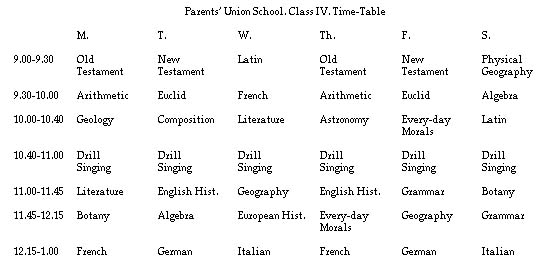

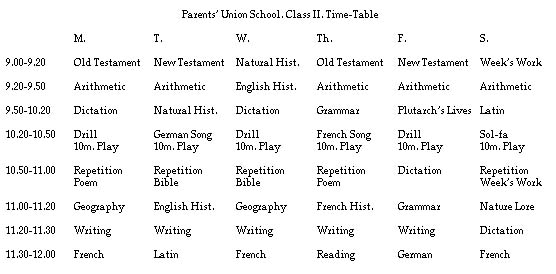
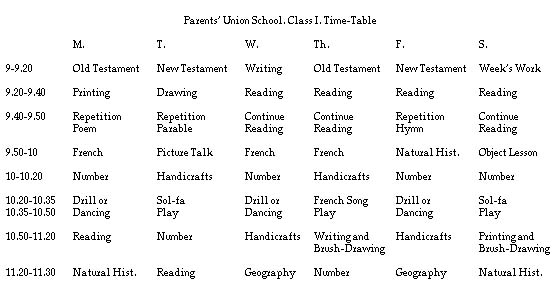
How can AmblesideOnline's curriculum be scheduled?
Taking all that has been stated above, here are some ways a year can be scheduled into a daily plan. These are very general examples, not rigid recommendations.
Here's one way Year 1, Week 1 might be scheduled. First, take the weekly readings:
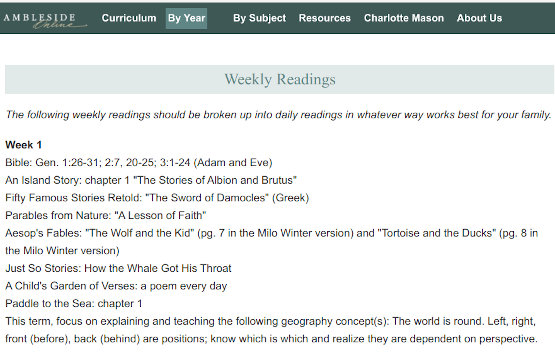
And spread them out over a week. For this example we'll use a five-day week. This can be hand-written or done on the computer. Some may choose to print a template and fill it in each week by hand. Here is Year 1 Week 1's readings filled in to a five-day schedule:
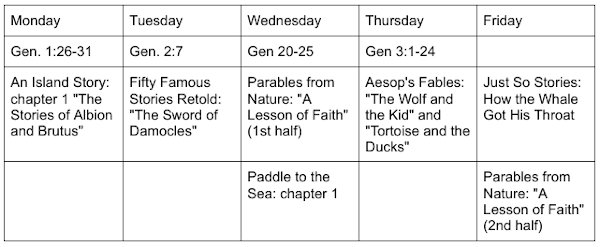
Notice that there is no Bible on Friday when mapped out this way, a Psalm or a section of Proverbs or any other Bible reading could be added to that day, or the other days' readings could be spread out.
Also notice that a longer reading -- Parables from Nature -- has been broken up into two readings.
If there are too many readings, one of the readings could be read at bedtime instead, or on the weekend, or in the car on audiobook, or pushed back to the following week, or even dropped {gasp} if needed. These types of scheduling choices are left up to each family and are often game-time decisions made to adjust to the realities of each week.
Next add the Daily and Weekly work from Year 1:

Now the schedule might look like this:

*Narrate all readings
If you would like to add times to this schedule, a left hand column could be added with times similar to those in the Parents' Union School examples above. (9 - 9:20, 9:20 - 9:40, etc.)
Remember, these are only examples. You may have a newborn and need more margin in your day, or an only child who can fly through their work. Consider the reality of your family's current circumstances along with your child's educational needs when scheduling. Some families will add time slots and stick to a firmer schedule while others will roll along in a rhythm from one thing to the next as the day allows.
Another way to schedule out the same content might look like this:
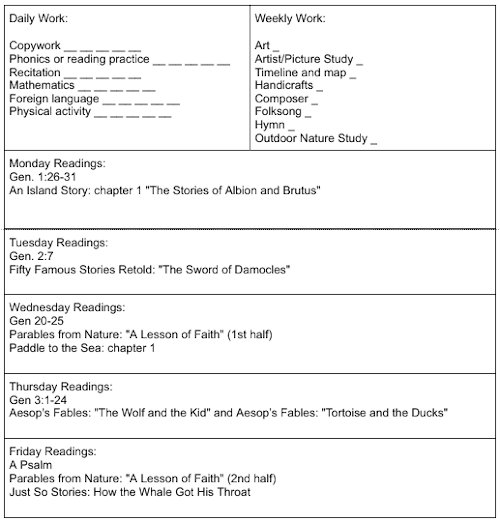
In this example, Daily and Weekly work is checked off in the space provided each day and throughout the week showing completion.
Books in a Basket
Another scheduling option we have heard of is keeping the term's books in a basket in the schooling area with bookmarks or tags indicating to the student what has to be read that week. The student can then be given a checklist for Daily and Weekly work like the one shown above and taught to make sure that the books in the basket are read through to the bookmark by the end of each week.
More Scheduling Resources
Here are some additional scheduling resources to help you decide what might work best for your family.
Sample Schedules and Suggestions from Users
One Advisory's sample schedules shows how every student even in the same family can differ in scheduling needs.
Should I Combine in One Year to Streamline Our Schedule?
AO Auxiliary member Brandy Vencel (AfterThoughts) has some tips with videos to help you create blank weekly chart templates and weekly schedules, and Creating Weekly Schedules for the Entire Year.
AO Auxiliary member Kathy Livingston has compiled all of her scheduling posts in one place on her blog, including explanations of how she scheduled Years 3, 5, 7 and 10 one year.
AO users also frequently share their scheduling resources in the AO Forum and Facebook group.
Multiples
Families with multiple young children may find a master schedule like the following one can be a helpful tool by scheduling the day around the parent's availability.

Auxiliary member Brandy Vencel's post Six Steps to Plan a Circle Time describes how you can plan a regular time when the family is all learning together before they move on to independent work. Also Making AmblesideOnline Work For A (Very) Large Family.
Again, these are general samples only.
AO for Groups
Another option for large families, co-ops, and cottage schools is AO for Groups. Brandy Vencel provides a tutorial for AO for Groups on her post How To Use AmblesideOnline For Groups: A Tutorial.
Each AO Year also provides a weekly chart by Term linked from the top of the Year's schedule page in multiple formats (PDF, DOC, ODT.)
How do I schedule AmblesideOnline for a Special Needs Student?
Many parents have had success using the AmblesideOnline curriculum for their special needs students. Here are some resources to consider if you are looking to schedule AmblesideOnline for a special needs student.
Placement For Learning-Disabled Students
Using AmblesideOnline with a Special Needs Child
We also have a private area in the AmblesideOnline Forum specifically for LD/Special Needs discussions.
How Can I Fit All of This In?
Looking at the schedule it can seem overwhelming. There are so many things that need to be taught. How can anyone teach so many different subjects?! This is a common misunderstanding of the role of the teacher in a Charlotte Mason education. We would encourage you to read the post A Charlotte Mason Teacher by Karen Glass to put your mind at ease about the complexity of the schedule.
Scheduling is a Process
Finding the right schedule is a process, don't expect to find the right one that will solve all of your problems and produce all of your desired results. The schedule is only a means to an end.
Charlotte Mason herself warns us: "There is always the danger that a method, a bona fide method, should degenerate into a mere system."
"If a human being were a machine, education could do no more for him than to set him in action in prescribed ways, and the work of the educator would be simply to adopt a good working system or set of systems.
But the educator has to deal with a self-acting, self-developing being, and his business is to guide, and assist in, the production of the latent good in that being, the dissipation of the latent evil, the preparation of the child to take his place in the world at his best, with every capacity for good that is in him developed into a power.
Though system is highly useful as an instrument of education, a 'system of education' is mischievous, as producing only mechanical action instead of the vital growth and movement of a living being." ~Home Education, pg. 9
Where can I get more scheduling help?
If you haven't done so already we highly recommend you take the time to read through the FAQ where we answer questions related to scheduling. We would also encourage you to visit us on the AmblesideOnline Community Forum with any further scheduling questions you may have.




